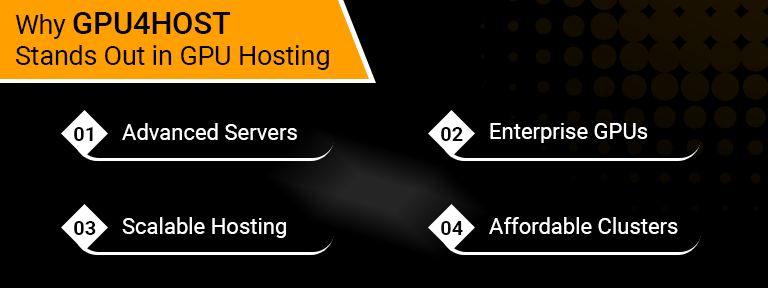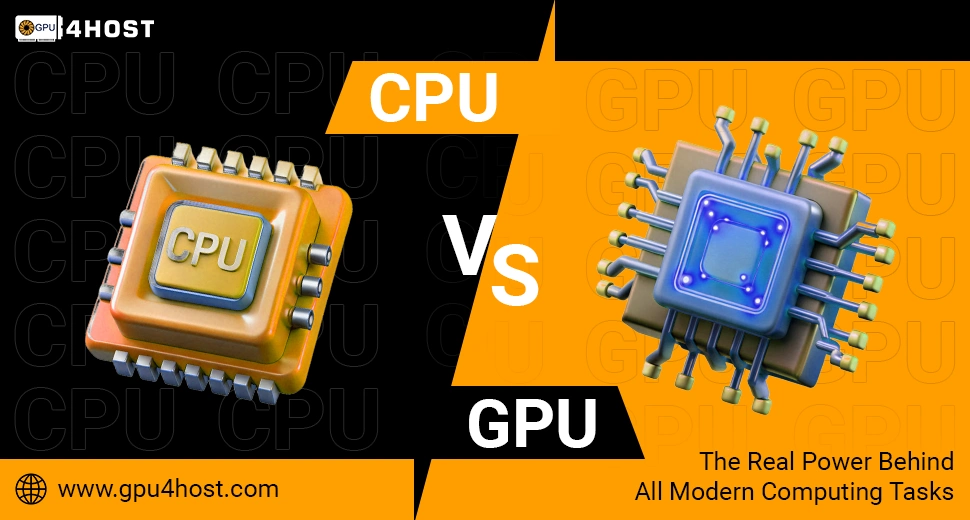CPU vs GPU: The Real Power Behind All Modern Computing Tasks
When it comes to powering the modern digital era, two core processing units lead the positive way: the CPU vs GPU. While both are necessary for computing, they serve very different tasks. Knowing about their roles can help you make a favorable decision when selecting between a basic hosting setup, a GPU server, or capitalizing heavily on a high-performance GPU dedicated server, especially for AI, high-quality graphics rendering, or gaming tasks.
In this knowledge base, we’ll simply break down CPU vs GPU in the easiest way possible. You will get to know how they are different, where every single one shines, and why businesses are increasingly shifting towards GPU hosting plans for modern computing.
What is a CPU?
The CPU (Central Processing Unit) is generally known as the “brain” of a system. It’s engineered to manage general-level workloads:
- Running your OS
- Managing apps
- Performing all calculations in sequence
- Managing logic and decision-making
Just think of the CPU as an expert multitasker who simply works on one essential thing at a time but switches instantly between different tasks. It’s best for daily tasks like web browsing, writing documents, and even handling servers.
What is a GPU?
The GPU (Graphics Processing Unit) was really engineered for rendering high-quality images and graphics. However, its proficiency to process tons of tasks at the same time has made it crucial in a lot of areas far beyond modern gaming.
A GPU server is now utilized for:
- AI image generator tools such as DALL·E or MidJourney
- Machine learning and deep learning
- Complex simulations
- Big data analytics
- High-resolution 3D rendering
Apart from the CPU’s multitasking style, the GPU outshines in the case of parallel computing, troubleshooting many small issues simultaneously.
CPU vs GPU: The Main Differences
Here’s the easiest way to know about the difference:
- CPU = Sequential power (fewer cores, highly versatile, ideal for basic computing)
- GPU = Parallel power (tons of cores, ideal for repetitive, data-intensive tasks)
Let’s just break it down more:
| Feature | CPU | GPU |
| Cores | Few (4 to 32 typically) | Thousands |
| Task type | General-level | Expert, repetitive, parallel |
| Perfect for | OS, web-based applications | AI, graphics rendering, scientific simulations |
| Use case | Word processing, cloud hosting | AI GPU clusters, deep learning, machine learning |
In the case of CPU vs GPU, you don’t easily replace one with the other—they always complement each other in many ways. The CPU handles complete system control, while the GPU boosts tasks that want raw parallel computing power.
Why Businesses Go For a GPU Server

The unstoppable growth of AI and big data has simply made a GPU server a requirement. Businesses that completely depend on machine learning, deep neural networks, or even high-resolution graphics processing are finding that CPUs alone are the most insufficient.
Here’s why GPU hosting is growing more and more:
- Speed: A GPU dedicated server can easily process huge datasets instantly and much more quickly as compared to CPUs.
- Flexibility: With the help of a GPU cluster, enterprises can scale AI-based model training smoothly.
- Versatility: Whether it is powering an AI image generator, running scientific simulations, or deploying cutting-edge analytics, GPUs adapt quickly.
- Performance: High-end graphics cards such as NVIDIA A100 provide exceptional performance for enterprise-level AI tasks.
Practical Examples of CPU vs GPU Usage
To make this more clear, let’s just have a look at some real-world situations:
- Web Hosting: A CPU-powered server that is sufficient for hosting sites, blogs, or running small business platforms.
- AI GPU Tasks: Training chatbots, running unique recommendation systems, or image recognition workloads that need a GPU server.
- Content Creators: Video editors and 3D designers want the speed of GPU hosting to render projects in no time.
- Enterprises: Companies that deploy cutting-edge AI pipelines depend on a GPU cluster and dedicated GPU servers for productivity.
NVIDIA A100 & the New Era of AI GPU Server
When talking about CPU vs GPU, it’s impossible to ignore today’s enhancements, such as the NVIDIA A100. This GPU is engineered mainly for high-performance computing (HPC), capable of running trillions of processes per second.
- Best for an AI GPU cluster
- Boosts all deep learning models
- Powers real-time AI image generator apps
- Provides exceptional performance in data centers
Service providers like GPU4HOST are making such a robust GPU server more easily available for new businesses, large enterprises, and researchers.
CPU vs GPU: Which One Do You Want?
The choice completely relies on your task demands:
- Go for a CPU server if:
- You want general-level computing
- Hosting sites or WordPress hosting
- Running general databases or small-level apps
- Go for a GPU server if:
- You are running AI or ML-based tasks
- Need quicker rendering or video processing
- Deploying an AI GPU cluster
- Utilizing AI image generator tools at scale
Why GPU4HOST Stands Out in GPU Hosting

When checking out all the possible GPU vs CPU solutions, selecting the appropriate hosting service provider is just as necessary as selecting the right hardware. GPU4HOST provides:
- Cutting-edge GPU dedicated server
- Constant support for Nvidia A100 and some other enterprise-level GPUs
- Scalable GPU hosting solutions for both startups and large enterprises
- Budget-friendly access to an AI GPU cluster
This always makes it a lot easier for developers, scientific researchers, and businesses to deploy AI-based tasks without stressing about infrastructure issues.
Key Conclusions on CPU vs GPU
- CPU vs GPU is not only about each other’s replacements but also about improving strengths.
- CPUs are ideal for general-level tasks and server management.
- GPUs rule in the case of AI/ML, graphics rendering, complex simulations, and data-intensive tasks.
- Businesses are now increasingly capitalizing more on GPU servers and GPU dedicated servers to meet AI task demands.
- Service providers like GPU4HOST make enterprise-level AI GPU clusters and cutting-edge solutions such as NVIDIA A100 available globally.
Winding UP
The ongoing debate of CPU vs GPU is not only about which is best—it’s all about selecting the best tool for the specific job. CPUs manage all control and multitasking, while GPUs offer raw power for data-intensive, parallel workloads.
In the modern AI-based world, pairing both gives businesses the advantage they want. With different solutions such as GPU hosting, a GPU dedicated server, and advanced GPUs like NVIDIA A100, popular platforms like GPU4HOST are making cutting-edge computing power more easily available than ever.
If your tasks are moving more towards AI, machine learning, or content-intensive tasks, it’s time to check out the future with a GPU server.


